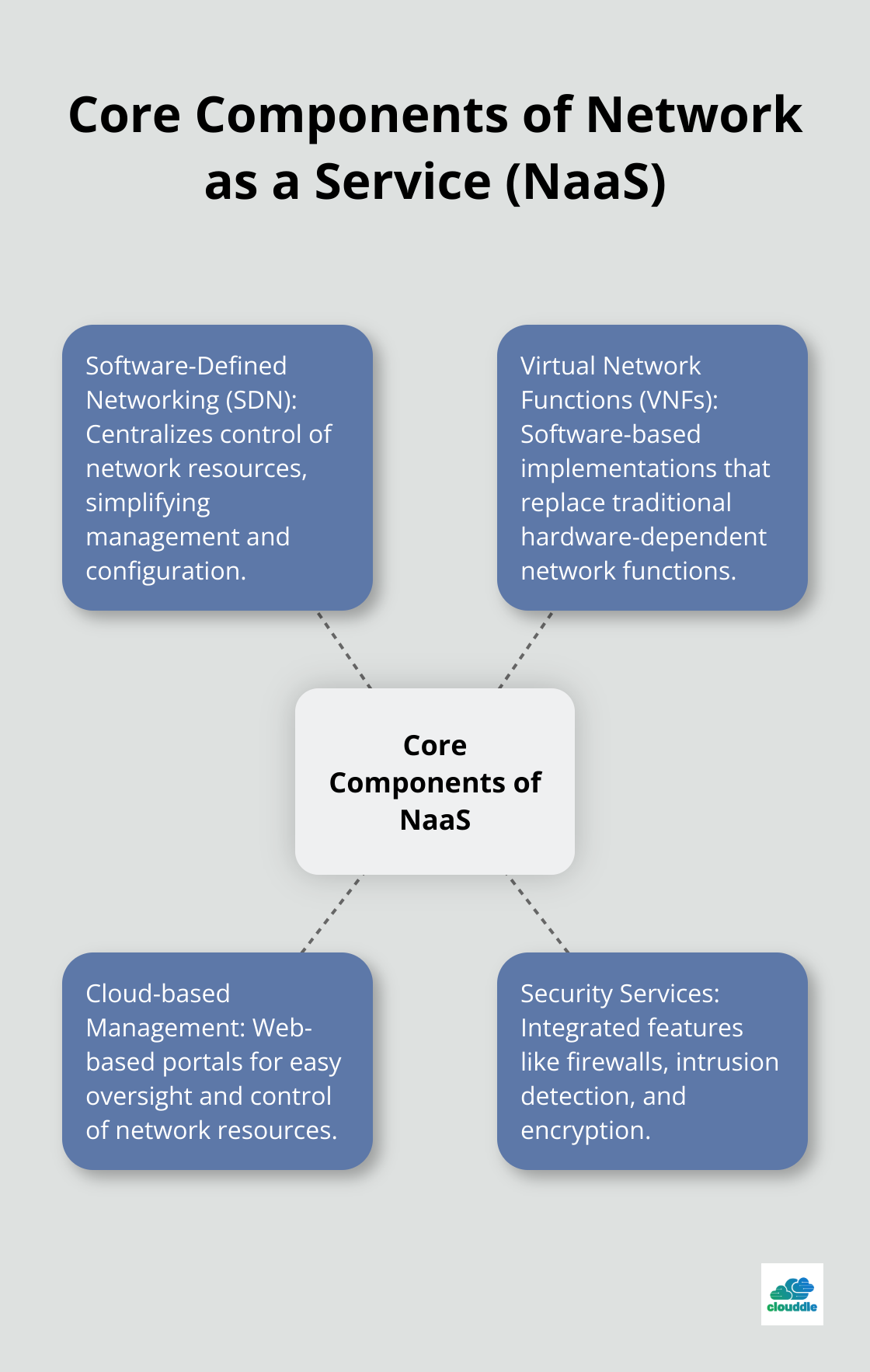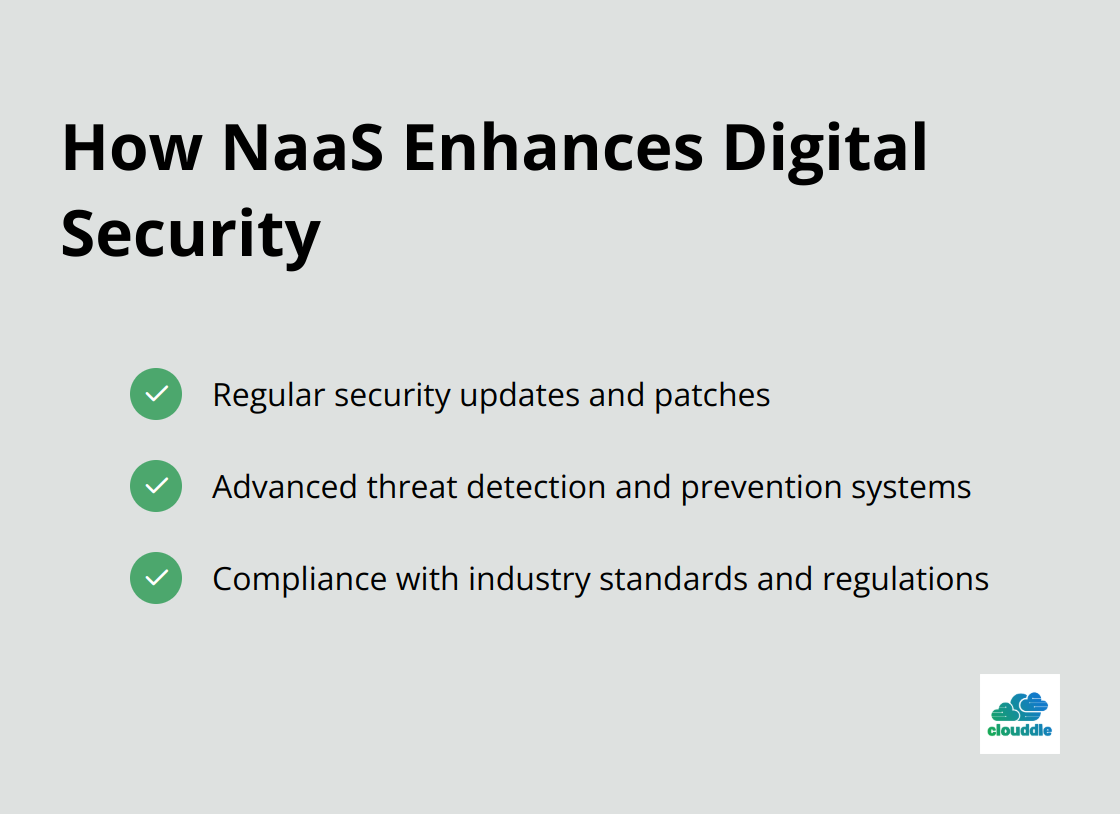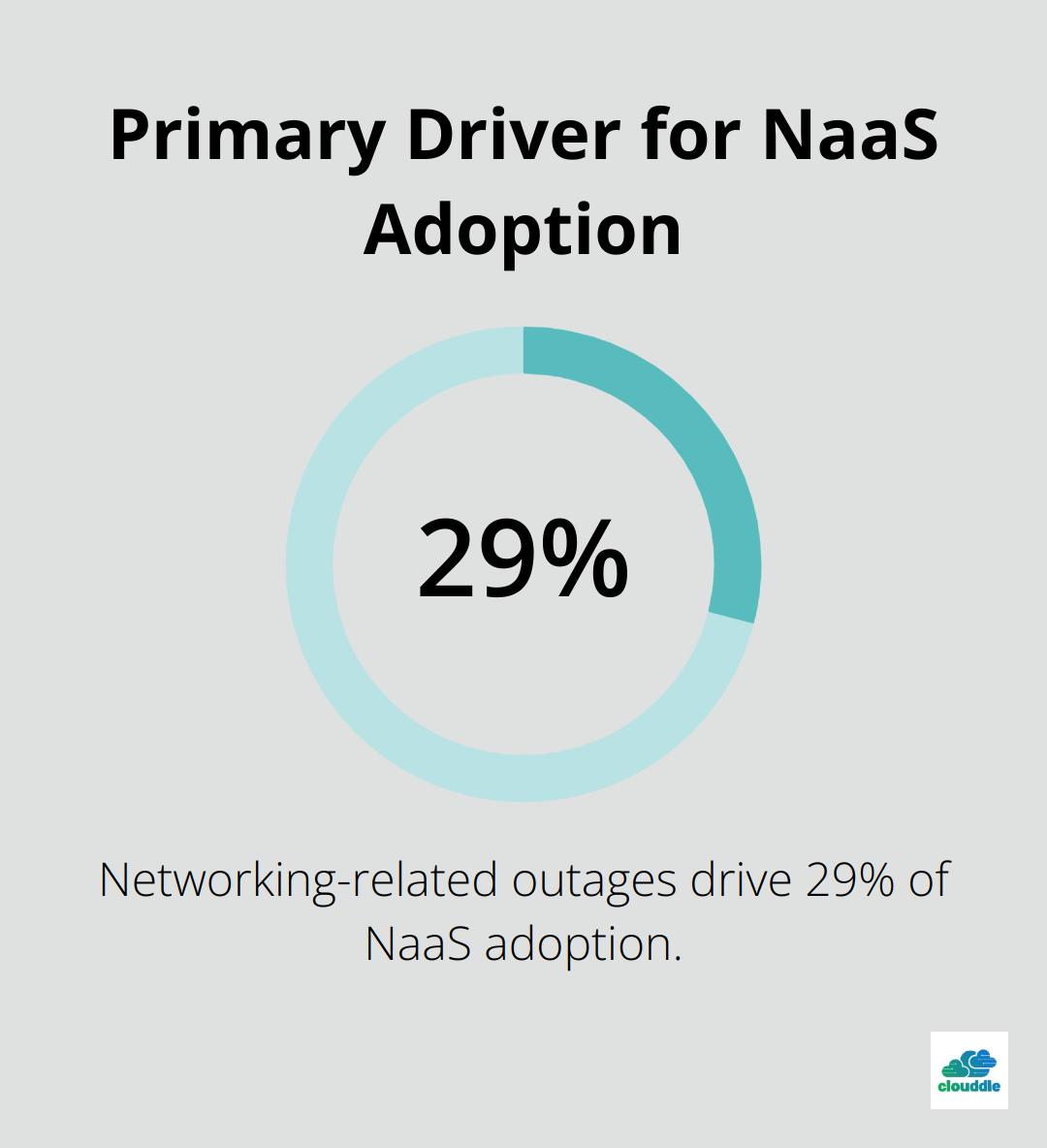Network as a Service (NaaS) is revolutionizing how businesses manage their network infrastructure. This innovative approach offers unparalleled flexibility, cost-efficiency, and scalability for organizations of all sizes.
At Clouddle, we’ve seen firsthand how NaaS can transform business operations. In this post, we’ll explore the benefits of NaaS and provide practical guidance on implementing it in your organization.
What is Network as a Service?
Definition and Core Components
Network as a Service (NaaS) is a cloud model that enables users to easily operate the network and achieve the outcomes they expect from it without owning, building, or maintaining it. This model mirrors other cloud services, providing flexibility and scalability. NaaS encompasses services such as WAN connectivity, network security, and virtual network functions, all delivered through a subscription-based model.
The core components of NaaS typically include:
- Software-Defined Networking (SDN): This technology centralizes control of network resources, simplifying management and configuration.
- Virtual Network Functions (VNFs): These software-based implementations replace traditional hardware-dependent network functions.
- Cloud-based Management: NaaS providers offer web-based portals for easy oversight and control of network resources.
- Security Services: Many NaaS offerings integrate built-in security features (e.g., firewalls, intrusion detection, and encryption).

The Shift from Traditional Networking
Traditional networking models require substantial upfront investments in hardware, software, and skilled personnel. These models often struggle to adapt to rapidly changing business needs. NaaS shifts the responsibility of network management to service providers, allowing businesses to concentrate on their core operations.
Key Players in the NaaS Market
The NaaS market features both traditional networking companies and cloud service providers. Some prominent players include:
- Cisco: Offers a comprehensive suite of networking services through its Cisco Network as a Service solution.
- Amazon Web Services (AWS): Provides various networking services as part of its cloud offering.
- Microsoft Azure: Integrates a range of networking services with its cloud platform.
- Clouddle: Delivers NaaS solutions tailored for specific industries (hospitality, multi-family dwelling, and senior living), combining networking, entertainment, and security services.
When selecting a NaaS provider, businesses should evaluate service offerings, security measures, and industry expertise. Clouddle’s focus on specific sectors, for example, allows for tailored solutions that address unique industry challenges.
As businesses embrace digital transformation, NaaS emerges as an attractive option. It offers the flexibility and scalability needed to support modern business operations while reducing the complexity and cost associated with traditional networking models. The next section will explore how these benefits translate into enhanced business operations.
How NaaS Boosts Your Business Operations
Effortless Scaling
Network as a Service (NaaS) revolutionizes how businesses handle network expansion. NaaS streamlines operations, cuts costs, and boosts efficiency for businesses. Traditional networking demands substantial investments in hardware and expertise for capacity growth. NaaS simplifies this process to a mere subscription adjustment.
A retail business can illustrate this advantage. During seasonal peaks, it can swiftly increase network capacity without investing in permanent infrastructure. This flexibility enables quick responses to market demands, ensuring optimal performance while avoiding overspending on unused capacity in slower periods.
Cost Predictability and Budget Optimization
NaaS transforms networking expenses from large, unpredictable capital expenditures into manageable, predictable operational costs. This shift profoundly impacts financial planning and cash flow management.
Organizations adopting NaaS can potentially reduce their total cost of ownership. This reduction stems from:
- Elimination of hardware purchases
- Lower maintenance costs
- Optimized resource allocation
Enhanced Digital Security
In our increasingly digital world, security stands paramount. NaaS providers typically offer robust security features, often surpassing what many businesses can implement independently.
NaaS helps mitigate security risks through:

For industries handling sensitive data (e.g., healthcare or finance), NaaS proves invaluable in maintaining compliance with regulations like HIPAA or PCI DSS.
Streamlined Network Management
Complex network infrastructure management can significantly drain IT resources. NaaS simplifies this process by transferring much of the day-to-day management to the service provider.
NaaS dramatically reduces the burden of routine maintenance tasks, allowing IT staff to focus on strategic initiatives that drive business growth.
Furthermore, NaaS providers offer sophisticated monitoring tools and analytics, providing deeper insights into network performance and usage patterns. This data proves invaluable for operation optimization and improvement area identification.
The next chapter will guide you through the process of implementing NaaS in your organization, ensuring a smooth transition to this game-changing technology.
How to Implement NaaS in Your Business
Evaluate Your Current Network
A thorough assessment of your existing network infrastructure forms the foundation for a successful NaaS implementation. This evaluation should include:
- Network performance metrics
- Current hardware and software inventory
- Security vulnerabilities
- Compliance requirements
- Bandwidth usage patterns
Emerging infections can spread quickly and gain strongholds to become endemic diseases, as demonstrated by long-term pandemics. This emphasizes the importance of a comprehensive network evaluation to identify areas where NaaS can provide immediate benefits.
Select the Right NaaS Provider
The choice of a NaaS provider impacts your entire organization. Consider these key factors:
- Service offerings aligned with your business needs
- Scalability and flexibility of the solution
- Security measures and compliance certifications
- Quality of customer support and service level agreements (SLAs)
- Integration capabilities with existing systems
Industry-specific expertise plays a vital role in provider selection. For example, businesses in the hospitality sector should prioritize providers (like Clouddle) that offer tailored NaaS solutions combining networking, entertainment, and security services.
Plan Your Migration Strategy
A well-structured migration strategy ensures a smooth transition to NaaS. Follow this step-by-step approach:
- Identify critical applications and services for priority migration
- Develop a timeline for phased migration
- Create a detailed inventory of all network assets
- Plan for data migration and backup
- Establish clear communication channels with stakeholders
Networking-related outages emerge as the primary driver for NaaS adoption, accounting for 29% of contributing factors. This underscores the importance of careful migration planning to minimize disruptions and maximize NaaS benefits.

Train Your Team
Proper training for IT staff and end-users underpins successful NaaS implementation. Focus on these areas:
- New management interfaces and tools
- Security best practices in a NaaS environment
- Troubleshooting procedures
- Effective use of self-service portals
Ensuring your team’s proficiency in emerging technologies will prove essential for maximizing your NaaS implementation benefits.
Monitor and Optimize
Continuous monitoring and optimization unlock the full potential of NaaS. Regularly review these aspects:
- Network performance metrics
- Security logs and incident reports
- User feedback and satisfaction levels
- Cost savings and ROI
This trend highlights the importance of ongoing optimization to ensure your NaaS solution keeps pace with evolving cloud technologies and business needs.
Final Thoughts
Network as a Service (NaaS) transforms how businesses approach their networking needs. It offers flexibility, cost-efficiency, and scalability, which empower organizations to streamline operations, enhance security, and focus on core business objectives. The advantages of NaaS for businesses include effortless scaling, predictable costs, enhanced security, and simplified management.
NaaS will continue to evolve with AI-driven network optimization, increased integration with edge computing technologies, and advanced security features. These developments will lead to more intelligent, responsive, and secure network solutions. The impact of NaaS on business operations frees up IT resources, reduces complexity, and provides greater visibility into network performance.
Clouddle offers tailored NaaS solutions for specific industries, combining networking, entertainment, and security services into a seamless package. Organizations that embrace NaaS ensure they have the agile, secure, and cost-effective network infrastructure needed to thrive in today’s fast-paced business environment.


